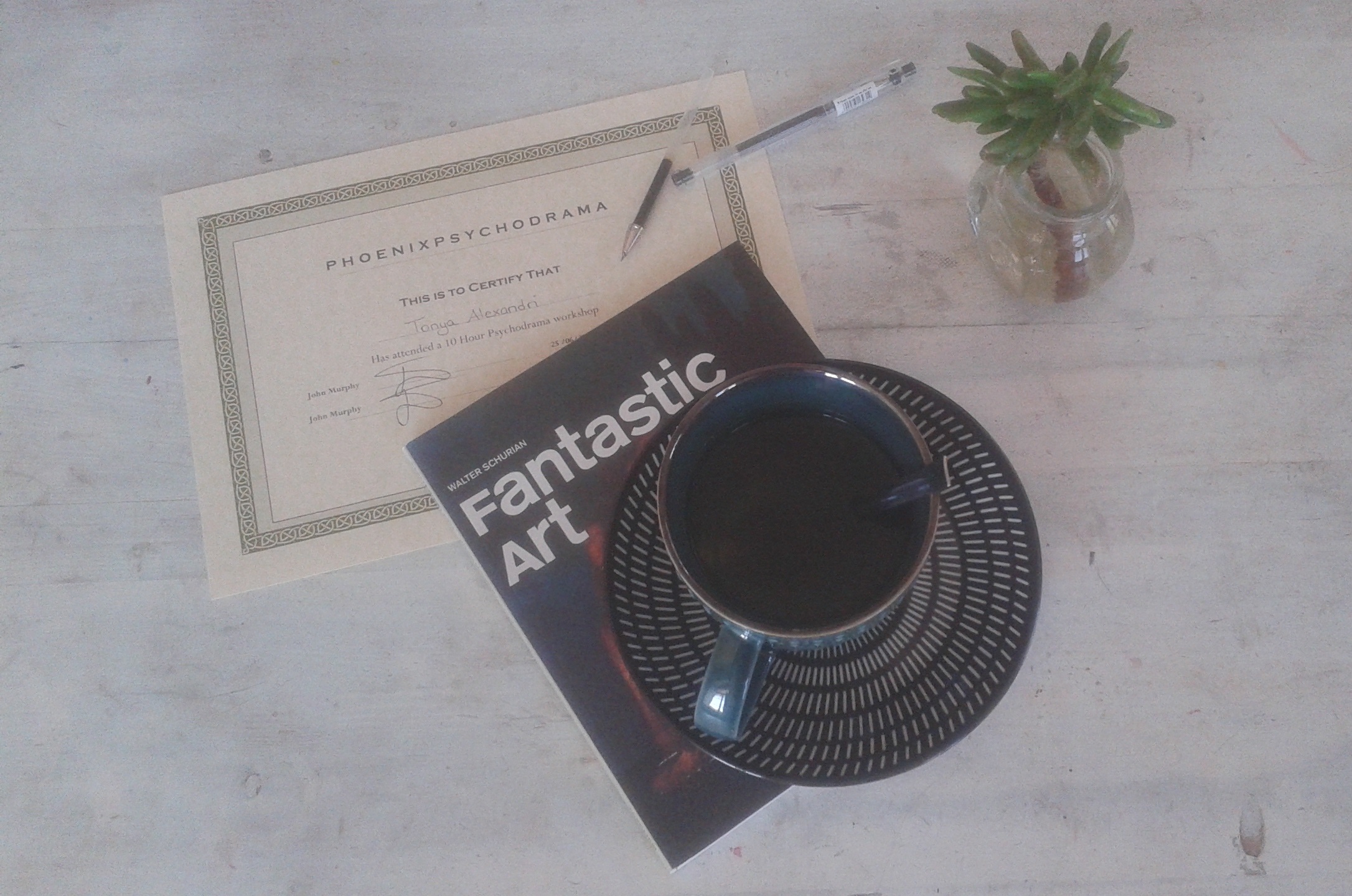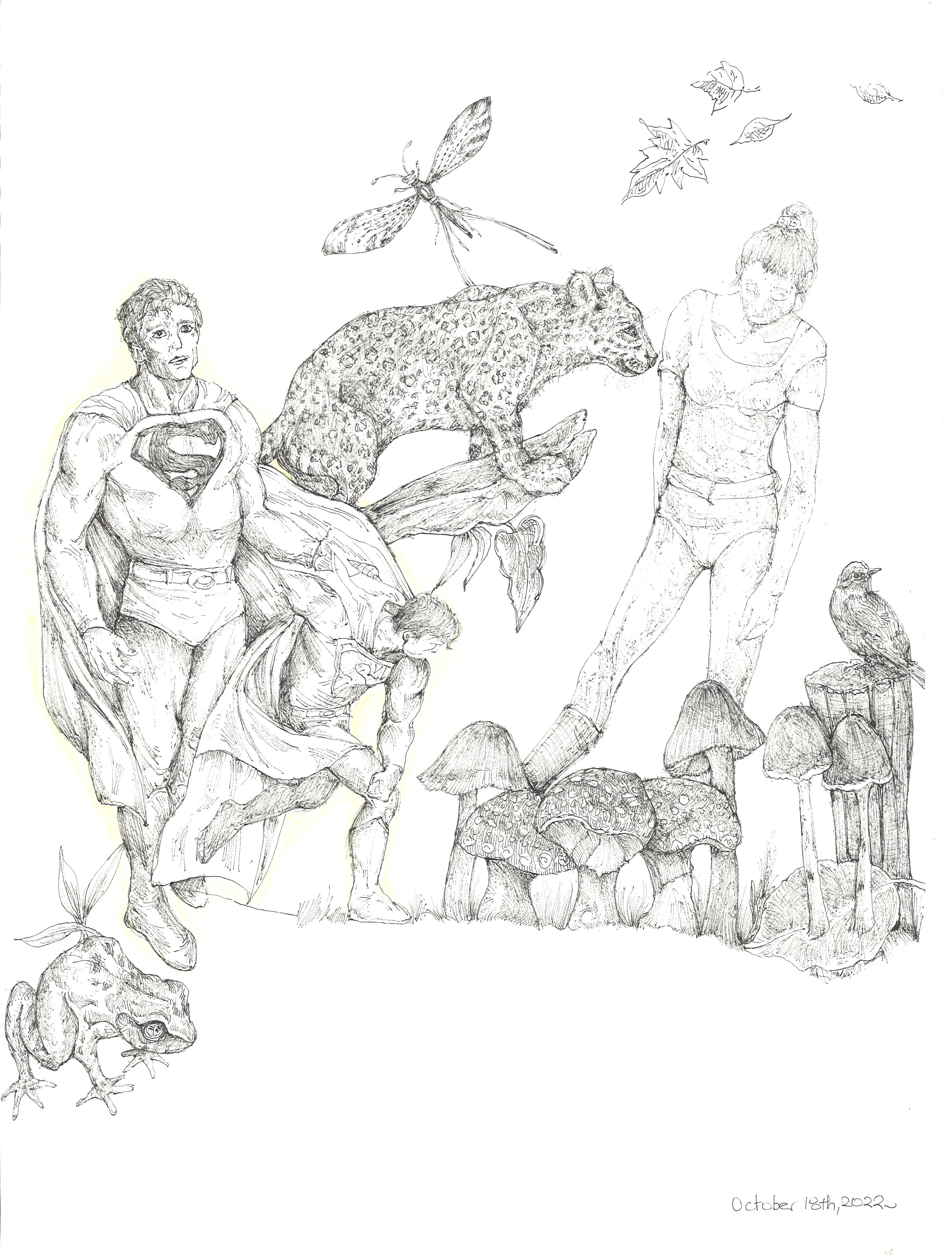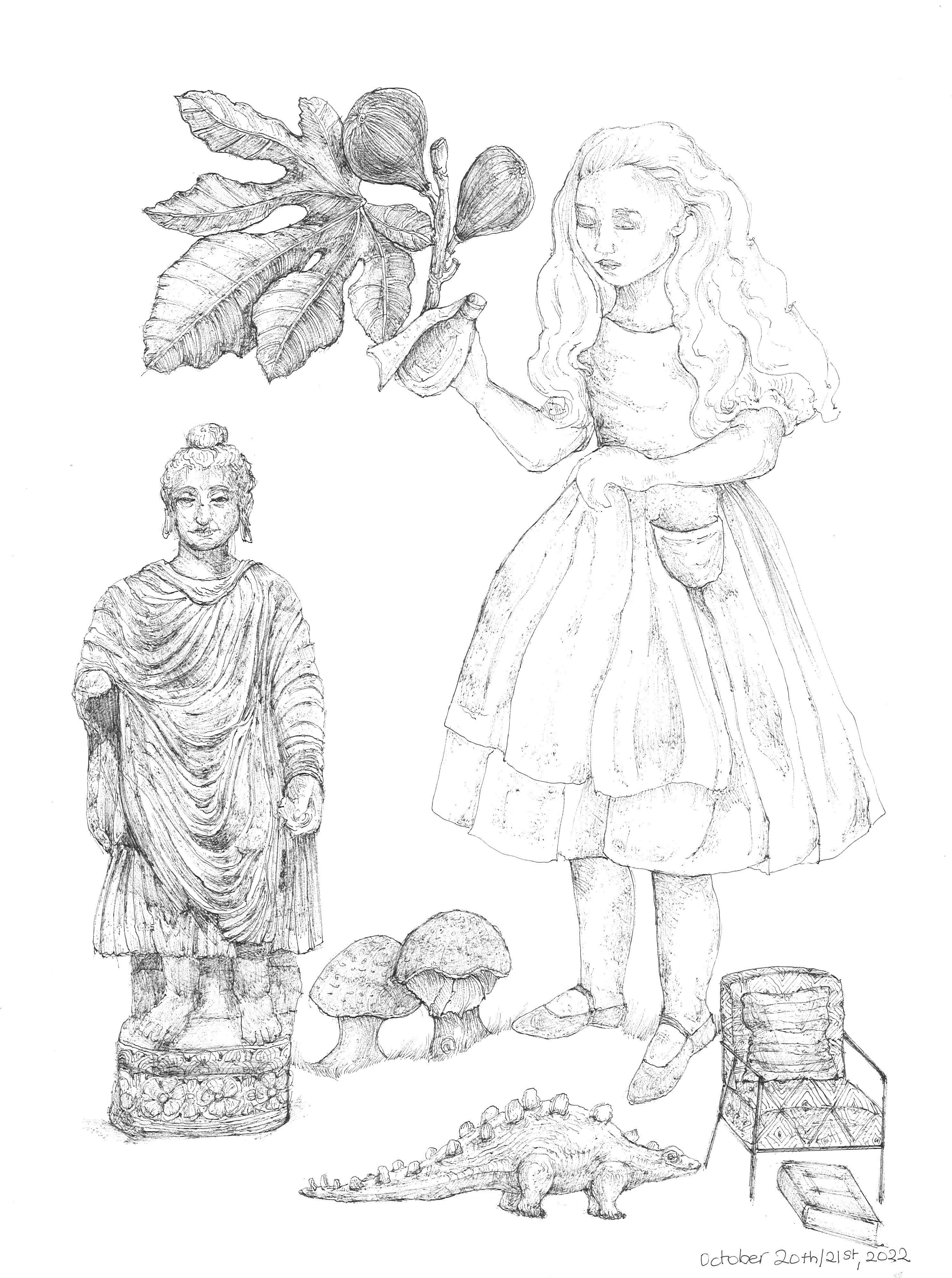Art, the DSM, psychedelic assisted therapy, acting, psychodrama, and safety
“Our sense of agency, how much we feel in control, is defined by our relationship with our bodies and its rhythms. In order to find our voice we have to be in our bodies – able to breathe fully and able to access our inner sensations. Acting is an experience of using your body to take your place in life.” Bessel van der Kolk

“The Buddha asks us to stop drifting thoughtlessly through our lives and instead to pay careful attention to simple truths that are everywhere available to us, clamoring for the sustained consideration they deserve.” Quote from the book In the Buddha’s Words
“Accumulated knots in the fabric of our body, previously undetected, begin to reveal themselves as we open.” Jack Kornfield
In today’s post I’m including some more drawings and some material and thoughts related to the therapy processes, mediation practices / exercises and two interesting articles.


1.In a recent BEING WELL podcast [https://www.youtube.com/watch?v=W_HJPYfukiY] Forrest and Rick Hanson had a conversation with Bessel van der Kolk, professor of Psychiatry at the Boston University School of Medicine and president of the Trauma Research Foundation in Massachusetts and author of The Body Keeps the Score, an influential book in the field of trauma and therapy. They discuss a lot of topics like the role that imagination, creativity and cultural context play in healing trauma and in moving beyond it. They talk about the need to confront trauma in pro-social movements and about how trauma and adverse experiences thwart agency, where agency begins and ways to reclaim it. They explore the reason we internalize abuse and abusive others, which is a natural and inevitable process of soaking up what others say or do to us, especially during our formative years. These messages become internalized limiting beliefs, and when the messaging is associated with trauma and fear, it becomes even more entrenched. We also get stuck in our coping responses during or after traumatic events. These get locked in our bodies. Bessel van der Kolk’s book title captures this experience.
Two other topics discussed are the many problematic issues with the DSM (Diagnostic and Statistical Manual of Mental Disorders), the need to integrate interpersonal processes and find new approaches to diagnosis and treatment, as well as, the current state of psychedelic assisted therapy research, the promise of this area and the many potential safety risks.
It’s not the first time I refer to this politically loaded topic of the DSM and the heavy criticism it has received and is receiving for the fact that the clusters of symptoms labeled as disorders are not scientifically proven, the fact that the majority of the people who have defined these health conditions and treatments are connected to pharmaceutical companies, the fact that childhood adverse experiences and social circumstances are not included. The most recent edition of the DSM surprisingly does not include Complex PTSD or Developmental Trauma Disorder. As a result in practice children and adolescents are given many other labels like: ADHD, conduct disorder, oppositional defiant disorder, anxiety and eating disorders, adjustment disorder, separation anxiety disorder, and so on. The focus is on the behaviours, on control of these adaptive and maladaptive behavioural responses and on symptoms that are often alternating but not on the root causes or the environment.
However, it is the first time I’m writing anything about psychedelic assisted therapy. I’ve recently been engaging with material related to this type of therapy and the research conducted currently, the potential of this field and the many pitfalls. As with all things that have the potential to do great good, they also have the potential to cause great harm. Psychedelics break down our ego boundaries, they deconstruct the completely separate from others, fixed and sometimes rigid sense of self that we have. It is suggested that this can help us get new insights about ourselves, our past and the world and it can help us embrace all aspects of ourself and our history, and also help us access our innate healing capacity if we are supported and assisted in integrating the experience and the information that arises. An all embracing love for everyone and everything may wash over us and a sense of deep interconnectedness. However, because we are in a state of such emotional openness and “boundarylessness” the therapist or guide has the power to break us down and violate our boundaries. In this very open state agency is lost, and therefore, severe violations can occur. Also, some people may have “bad trips”, encounter overwhelming buried experiences and / or fear based conditioning and other kinds of deep trauma that may be perceived or interpreted as spiritual experiences.
Therefore, a safe holding container with people who have the know-how that can help people integrate and understand their experience without imposing their views and interpretations is important. There is a need for screening who would potentially benefit from this process, for preparation in advance, and also integration of the experience after the psychedelic session, which might be a lengthy process. Above all it should take place in safe contexts with educated and / or experienced practitioners or guides. Integrity and self awareness as well as transparency, experience and knowledge are essential. An overall trauma informed and respectful environment could safeguard everyone involved. In the podcast notes Forrest mentions a prominent documented instance of shocking misuse of power perpetrated by Meaghan Buisson’s (an athlete and international medalist) therapists during a research trial session.
Also, as discussed in the podcast psychedelics might not be for everyone, and when it comes to therapeutic interventions one size does not fit all. It has been suggested that “letting go” of our ego might be a privilege and might not be appropriate for everyone or in all situations and contexts. The prospect of “ego death” or ego dissolution might not be for those whose cultural identity is threatened, for instance. And of course safety in all its different forms is not relevant only to psychedelic assisted therapy, regular bad psychotherapy can be harmful, and different levels of harm can be inflicted in all kinds of health, educational and training contexts.
In addition, the discussion includes exploration of the various therapeutic modalities that are available now, and specifically, they describe how movement, art and theatre can assist us in recovery and in reclaiming agency and power. In his book Bessel van der Kolk describes the use of psychodrama and acting in helping people move beyond trauma and also reclaim confidence. He talks about how he initially encountered Bryan Doerries’ project “The Theater of War” and how he came to understand that psychodrama and acting could be beneficial in healing trauma and in boosting confidence and faith in oneself. He writes “Greek drama may have served as a ritual reintegration for combat veterans” and “Acting is an experience of using your body to take your place in life.” He writes that he also became convinced of the therapeutic possibilities of theatre by witnessing his young son’s recovery from what we may call “chronic fatigue syndrome.”
In his book he talks about his observation and study of three different programs for treating traumatized, angry, frightened, and obstreperous teenagers or withdrawn, alcoholic, burned-out veterans through theater, that all share the common foundation, the confrontation of the painful realities of life and symbolic transformation through communal action. B van der Kolk notes: “Traumatized people are terrified to feel deeply. They are afraid to experience their emotions, because emotions lead to loss of control. In contrast, theater is about embodying emotions, giving voice to them, becoming rhythmically engaged, taking on and embodying different roles….. Theater gives trauma survivors a chance to connect with one another by deeply experiencing their common humanity.” Referring to children and adolescents he writes: “These kids are facing their own period of transition; many are barely articulate, and some struggle to read at all…. At the beginning of the process, many of these kids can barely get a line out. Progress is slow, as each actor slowly internalizes the words…. The idea is to inspire the actors to sense their reactions to the words— and so to discover the character….. ….”. The aim of theatre programs is group building through establishing basic agreements: responsibility, accountability, respect, expressions of affection, to teach cause and effect and to help kids and adults get in tune with one another and learn to trust again. He writes that for children becoming embodied and “en-languaged” can be a life-changing process.
Bessel van der Kolk also dedicates a chapter in his book to psychodrama, in which a person in some sense dramatizes a relationship perhaps with an early attachment figure or a difficulty in their life. He tells us about his training with Pesso and the use of tableaus or “structures” of the protagonists’ past. The director/ therapist and other group members ideally provide protagonists with the support they need to delve into whatever hurts. Group participants are asked to play the roles of significant people in the protagonists’ lives, such as parents, other family members, and so on. In this way one’s inner world takes form in a three-dimensional space. Then group members get to play the ideal, wished-for parents or other authority figure providing the support and witnessing what had been lacking, creating other possibilities and healing. Van der Kolk explains that projecting our inner world into the three-dimensional space of a structure enables you to see what’s happening in the theater of our mind and gives us a clearer perspective on our reactions to people and events in the past. As we position placeholders (people or objects like furniture) for the important people in our life, we may encounter past memories, thoughts, and emotions that come up, and then by moving the pieces around on the external chessboard that we’ve created we gain insights and create different endings. He writes: “Structures do not erase bad memories, or even neutralize them the way EMDR does. Instead, a structure offers fresh options— an alternative memory in which your basic human needs are met and your longings for love and protection are fulfilled.”
2.Two meditation practices I return to:
A more lengthy gentle, compassionate and gratitude infused body scan exercise from Chris Germer, PhD, who is a clinical psychologist, teacher of mindfulness and compassion, author and developer, along with Kristin Neff, of the Mindful Self-Compassion training program: https://www.youtube.com/watch?v=AmZdRE83tVU
The Wheel of Awareness meditation, which also includes a short body scan, from Dr Dan Siegel, One place you can listen to the guided practice is at his website at: https://drdansiegel.com/wheel-of-awareness. There are longer and shorter versions at his website. I’ve written about this practice in the past posts if anyone wants to read about it. Dan Siegel writes that the wheel of awareness becomes a visual metaphor for the integration of consciousness as we differentiate rim-elements, which are the known, what we know and hub-awareness, which is our human capacity of knowing, from each other and link them with our focus of attention. Also, there is an interesting part (hub of awareness) in the longer practice during which we almost always experience a brief emotional opening, a sense of unconditional love, joy, freedom.
3. Finally, for those interested and in the mood of reading I’m sharing links to two articles about psychedelics, the socialization of hallucinations, Northern Renaissance painting, St Anthony’s fire or ergotism, a disease that resembles the bubonic plague, produced by eating food affected by ergot, a toxic fungus that infects rye, often with detrimental effects.
a) A research article: The socialization of hallucinations: Cultural priors, social interactions, and contextual factors in the use of psychedelics by David Dupuis by at: https://journals.sagepub.com/doi/full/10.1177/1363461521103638
Dupuis distinguishes two levels of socialization of hallucinations. He argues that cultural background and social interactions organize the relationship both to the hallucinogenic experience and its content. He accounts for the underpinnings of the socialization of hallucinations proposing such factors as the education of attention, the categorization of perceptions, and the shaping of emotions and expectations. Dupuis cites Claude Lévi-Strauss (1970, p. 13), who has proposed to consider hallucinogens as “triggers and amplifiers of a latent discourse that each culture holds in reserve and for which drugs can allow or facilitate the elaboration.”
b) For those interested in art an article on Northern Renaissance painting, St Anthony’s fire or ergotism and more at:https://hyperallergic.com/399385/how-renaissance-painting-smoldered-with-a-little-known-hallucinogen/
Extracts from the article:
“A fungal infection known as ergotism influenced Northern Renaissance painting to an extent that a majority of art institutions have yet to grapple with. During the Renaissance ergotism was colloquially known as St. Anthony’s Fire, named for the third-century desert Father who had hallucinatory bouts….. During the time of the Renaissance, ergotism was a phantasmagoric event with an onset that was difficult to distinguish from the bubonic plague: it came on first as nausea and insomnia, then developed into sensations of being engulfed in flames while hallucinating over several days, and often ended with the amputation of one or more limbs due to gangrene, or ended in death. The illness is contracted by ingesting ergot fungus, which appears on cereal grains when the growing conditions are right ….. The last known severe outbreak occurred in the French village of Pont-Saint-Espirit in 1951….
Some art historians, such as Bosch scholar Laurinda S. Dixon, have proffered for decades that the symptoms of ergotism influenced painters like Jheronimus (aka Hieronymus) Bosch and Matthias Grünewald. In looking further at depictions of Saint Anthony — from medieval folk art, a plethora of Renaissance work, to a series of paintings by surrealist artists, such as Max Ernst’s 1945, “The Temptation of Saint Anthony” — a pattern begins to develop in which a mimesis of visual hallucinations associated with ergotism is clearly present. For instance, Gustave Flaubert’s novel The Temptation of Saint Anthony, contains not only hallucinatory imagery congruent with the effects of ergot alkaloids, but also contains in the opening passage of the novel a clear symbol of a known cause of ergot poisoning: a description of a loaf of black bread inside the hermit saint’s cabin…. Laurinda S. Dixon presents some of the most convincing evidence to date that Bosch’s imagery was directly influenced by Saint Anthony’s Fire. In a (1984) essay titled “Bosch’s St. Anthony Triptych — An Apothecary’s Apotheosis,” the author finds a common ingredient in medieval medicine used to treat ergot — mandrake root — and the distillation furnaces used to make that medicine. Examining the Bosch painting with the use of high resolution photos …. Dixon argues that the bulbous buildings, often depicted with a stream of smoke coming out of the top, are nearly identical to the shapes found in contemporaneous schematics of apothecary furnaces……”
